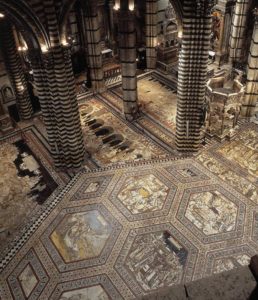
Incorporating Romanesque, French Gothic, and Classical architecture, the façade of Siena’s marble Duomo (cathedral) looms in cultivated grandeur. Until January 6, 2015 there is a unique opportunity to explore the Cathedral and its environs from an elevated perspective.
After a long restoration, visitors can access an aerial walkway circumnavigating the church’s perimeter. The Doorway to the Sky (La Porta del Cielo), combines a trip into the Cathedral’s history, a close-up of the dome’s interior, a spectacular overview of inlaid marble pavements and, once outside, the surrounding town and countryside (cost: 25 euro, 7 euro for children under 7) and reservations are necessary: www.operaduomo.siena.it).
Polarized by black stripes, the polychrome marble is blinding in its white hues. On the lower section, Gothic statues decorate the wall. These sculptures were designed by Giovanni Pisano, the church’s foreman from 1284 to 1297. On either side of the façade, two towers flank the cathedral’s entrance; once inside, spiral staircases lead visitors from the base of the church to the “Doorway to the Sky.”
Accompanied by a guide, small groups are chaperoned through corridors and walkways. Projecting from the brickwork in a horizontal lunge, marble gargoyles, once situated on the exterior, now ornament the walls of the first hallway. Down the spine of each, there is a groove through which rainwater once traveled from the base of the back to the jaw of the beast.
Following this introductory corridor, there is a historical display detailing the construction of the Duomo. To the left, the dome’s stained glass windows embellish the otherwise plain walls. Once out on the two exterior walkways, Siena’s uniquely colored brickwork can be admired in its unhindered scope.
For all it subtle beauties, this salmon tinted cityscape recalls Anglo-Saxon romanticization of Italy. Beyond Siena’s borders, the mountainous terrain stretches in its lush expanse – reminding the viewer of the town’s limits and the beauty of its countryside lying just outside the city’s margins.
Halfway through the tour, the dome of Siena’s cathedral can be better appreciated from a narrow balcony. Above, vivid gold stars bedeck the ceiling’s blue coffers, all of which culminate with Gian Lorenzo Bernini’s golden lantern.
Below this balcony, the cathedral’s gothic-style pulpit can be observed from a more favorable perspective. Sculpted from Carrara marble, this impressive pulpit was started by Nicola Pisano at the end of 1265 and was completed in 1268. Surrounding it are the cupola’s supportive pillars, again notable for their black and white design (colors that are seen throughout the Duomo’s exterior as well as interior architecture, representing the founders of the city, Senius and Aschius).
At the end of the tour, the visitor is below the façade’s stained glass window, which portrays the Last Supper. Looking down, there is a stunning view of the 56 marble floor mosaics. Designed from the 14th up to the 19th centuries, each inlay depicts a story of salvation taken from the Scriptures.
Descending the spiral staircase, the visitor is reintroduced into Siena’s Middle Age metropolis. The city’s refined construction is a crowning evocation of Tuscany at a cultural and artistic zenith. Alongside the neighboring towns of Certaldo, San Gimignano and Colle di Val d’Elsa, the region’s medieval ancestry is still alive and vital. (graham hacia)







